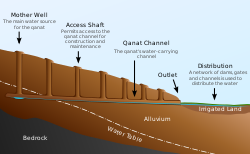 | |
| Alternative name | Filtration Galleries |
|---|---|
| Location | Nazca, Ica Region, Peru |
| Coordinates | 14°49′34″S 74°54′40″W / 14.826°S 74.911°W |
| Type | irrigation system |
| History | |
| Founded | c. 500 CE |
| Abandoned | Still in use |




Puquios (from Quechua pukyu meaning source, spring, or water well) are ancient systems of subterranean aqueducts which allow water to be transported over long distances in hot dry climates without loss of much of the water to evaporation. Puquios are found in the coastal deserts of southern Peru, especially in the Nazca region, and northern Chile. Forty-three puquios in the Nazca region were still in use in the early 21st century and relied upon to bring fresh water for irrigation and domestic use into desert settlements. The origin and dating of the Nazca puquios is disputed, although some archaeologists have estimated that their construction began about 500 CE by indigenous people of the Nazca culture.[1]
The technology of the puquios is similar to that of the Qanats of Iran and other desert areas of Asia and Europe, including Spain. A few puquios in northern Chile and in other parts of Peru were probably constructed at the initiative of the Spanish after the conquest of the Inca Empire in the 16th century.[2]
- ^ Schreiber, Katharina; Lancho Rojas, Josue (1995). "The Puquios of Nasca". Latin American Antiquity. 6 (3): 252–253. doi:10.2307/971674. JSTOR 971674. S2CID 163646495. Retrieved 9 April 2021.
- ^ Lane, Kevin (2017). "Puquios and Aqueducts in the Central Andes of South America". Underground Aqueducts Handbook. Boca Raton, Florida: CRC Press: 465–467.. In Underground Aqueducts Handbook.
